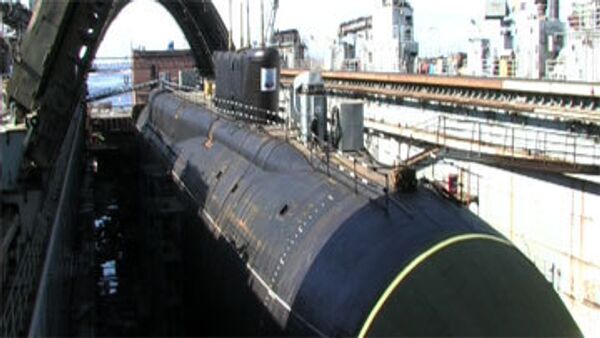The unsuccessful Bulava missile test calls into question the entire development strategy Russia has chosen for its strategic nuclear forces. At present the Russian Navy plans to introduce eight Project 955 submarines armed with 16 R-30 Bulava ballistic missiles for strategic nuclear purposes in the next 10 to 12 years. The failed missile test calls these plans into question.
At present, the first Project 955 ballistic missile submarine, the Yuri Dolgoruky, is being tested, while another two - the Alexander Nevsky and the Vladimir Monomakh - are expected to be launched in 2010 and 2011 respectively. Construction is slated to begin on the fourth submarine in the series - called the Svyatitel Nikolai according to some sources - on December 22, 2009.
After the failed Bulava missile test on December 9, 2009, the issue was raised once again of the feasibility of the current plan and possible alternatives to the Bulava. On December 11, Nikolai Kalistratov, the director of the Sevmash plant that builds the Project 955 nuclear submarines, said that it was necessary to consider the practicality of building a fourth Project 955 ballistic missile submarine in the absence of a "flying" missile. Some media sources have reported that initial construction of the new ballistic missile submarine had been postponed, although the Russian Defense Ministry denied these reports. Nevertheless, unnamed sources in the ministry subsequently reported that initial construction on the fourth Project 955 submarine had been postponed until the first quarter of 2010.
The Bulava tests are expected to resume in the first quarter of next year: in March 2010 to be exact. A number of experts see a connection between these two events and believe the decision to continue building Project 955 submarines will depend on the results of the next missile launch.
The Bulava is currently the only ballistic missile that can be deployed on the new submarines. There has been some discussion of refitting the Project 955 submarines to carry the liquid-fueled Sineva missile, but this would require considerable time and additional funding. Reviving the Bark Project, which was mothballed after work began on the Bulava, will take even more time, and, because of the size and weight of the missile, refitting the new submarines for the Bark would be even more difficult, if not outright impossible.
There is also the option of using the Project 955 submarines that have already been built or are under construction as cruise missile submarines before they can be modified for the Bulava, similarly to how the U.S. Navy uses four out of its 18 existing Ohio-class nuclear submarines. This option would require the least amount of time and resources, but cruise missiles cannot serve as a satisfactory replacement for ballistic missiles.
The core of Russia's strategic nuclear forces currently consists of 11 ballistic missile submarines armed with Makeyev Design Bureau missiles - five Project 667BDR nuclear submarines armed with R-29R missiles and six Project 667BDRMs nuclear submarines armed with R-29RM and R-29RMU Sineva missiles. Nevertheless, these vessels will be decommissioned in the near future due to their physical aging; the Project 667BDRs will be retired in the next five to seven years and the Project 667BDRMs in 10 to 20 years.
Consequently, it is possible to predict the following scenarios if the next Bulava test is a failure:
1. Missile submarine construction could be put on hold until the missile is finished or a new project of similar dimensions is developed. The completed Yuri Dolgoruky and the nearly-completed Project 955 nuclear submarines could be temporarily converted into cruise missile submarines similar to the refitted American Ohio-class missile submarines.
2. Construction on the series could be halted until an upgraded Project 955 capable of carrying the Sineva can be developed. The completed Yuri Dolgoruky and the nearly completed Project 955 nuclear submarines could also be refitted for the Sineva by replacing the missile compartment, as was done during the Soviet era when a series of Project 667A missile submarines were upgraded.
Both options would take a long time, and so the new fleet of strategic nuclear submarines could not actually be deployed until after 2015, which would require prolonging the service lives of the Project 667BDRM and possibly the Project 667BDR submarines. In addition, due to their age, considerable resources would have to be spent on overhauling and modernizing these older submarines to extend their service lives for the more or less long term.
It is apparent that a failure to bring the Bulava missile to a state of operational readiness would entail spending many billions of rubles to ensure the combat readiness of the strategic nuclear fleet. Moreover, the possibility cannot be ruled out of a breakdown in the strategic nuclear fleet's capabilities in the second half of the 2010s or the early 2020s. This would increase the burden on the two remaining pillars of the security triad - the Strategic Missile Force and long-range aviation. In this case, additional spending would be required to increase the combat strength of these two pillars in light of decreasing naval capabilities.
The reasons for such a situation are myriad, but Kalistratov clearly expressed the main reason in the aforementioned statement on December 11: "In both sports and in military hardware, you have to practice constantly. And we haven't practiced in this in our country for 15 years."
MOSCOW. (RIA Novosti military commentator Ilya Kramnik)



